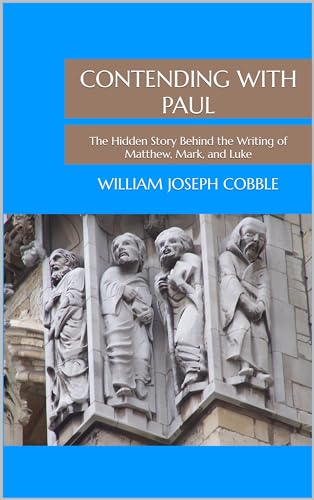Join our list
Subscribe to our mailing list and get interesting stuff and updates to your email inbox.

Author(s): William Joseph Cobble
Price: $2.99 (Apr 30 – May 6)
“Greet Urbanus, our co-worker in Christ …” (Romans 16:9)
“As for Titus, he is my partner and co-worker in your service …” (2nd Corinthians 8:23)
“Epaphroditus – my brother and co-worker and fellow soldier …” (Philippians 2:25)
“… together with Clement and the rest of my co-workers …” (Philippians 4:3)
“These are the only ones of the circumcision among my co-workers …” (Colossians 4:11)
“… and we sent Timothy, our brother and co-worker …” (1st Thessalonians 3:2)
“To Philemon our dear friend and co-worker …” (Philemon 2)
“The term sunergos (fellow worker, helper, co-worker) is used in the New Testament to describe individuals who work alongside others in the ministry of the Gospel. It emphasizes collaboration and partnership in the work of God. The word conveys a sense of unity and shared purpose among believers as they labor together for the advancement of the Kingdom of God.” – Berean Strong’s Lexicon
As Paul took the Gospel into the Graeco-Roman world, who were the men and women who partnered with him? In Paul’s letters, their names are sometimes found within a verse or passage from which some biographical or historical information can be gleaned. In these places, Paul might disclose a co-worker’s role within his ongoing work, divulge the part they played in some internal controversy, or even eulogize their passing. When also found in the Book of Acts, additional clues are occasionally available that help one to further discern the “when, where, and how” of the co-worker’s involvement in Paul’s missionary endeavors.

Author(s): William Joseph Cobble
Price: $2.99 (Apr 30 – May 6)
The Christian New Testament is best understood as a library. Housed upon its shelves are twenty-seven works, thirteen of which are letters that purport to be written by Paul. Yet, since the 1800s, scholars have adamantly disputed Paul’s authorship of six of these. Why? What is found within the six Disputed Letters that raises such doubt?
Hidden within these letters are statements such as the ones below which sound very unlike the Paul of the seven Undisputed Letters:
* Women achieve salvation through childbirth: “Yet she will be saved through childbearing providing they continue in faith and love and holiness, with modesty.” (1st Timothy 2:15)
* Women are to be subjugated within the church: “I permit no woman to teach or to have authority over a man; she is to keep silent.” (1st Timothy 2:12)
* Slaves must obey their masters as they would obey Jesus: “Slaves, obey your earthly masters with fear and trembling, in singleness of heart, as you obey Christ…” (Ephesians 6:5)
* Jesus’ sufferings were insufficient for the Church, but Paul’s are not: “I am now rejoicing in my sufferings for your sake, and in my flesh I am completing what is lacking in Christ’s afflictions for the sake of his body, that is, the church.” (Colossians 1:24)

Author(s): William Joseph Cobble
Price: $2.99 (Apr 30 – May 6)
Using a blend of history, theology, biography, and literary criticism, Contending with Paul focuses primarily on the first two generations of the Christian movement. It is the first generation who would initially debate how the message of Jesus should be presented to the Gentile world (non-Jews) and what would be expected of those Gentiles who desired to follow Jesus. It is the second generation of believers who began to write in a new literary genre that Christians call “gospels.” The Gospel of Matthew, the Gospel of Mark, and the Gospel of Luke, are the earliest three to have survived, and it is through these writings that the debates of the first generation get carried forward by the second. Though all three gospels were written after the death of Paul, it is asserted by the author that each gospel writer contended with his continuing influence in some way, though each from their own distinctive vantage point.
Paul’s influence may be underestimated if one only counts his 13 extant works in the New Testament. For the benefit of using a round number, it can be estimated that Paul ministered for 30 years. Also, for the sake of a round number, the churches and individuals to whom he corresponded may be estimated to be 20. Supposing he wrote to each of these entities twice a year, Paul’s total ministerial correspondence would rise from his 13 extant works to an output of 1,200. Paul would likely have been a dynamic figure in person as well. He is portrayed as a vigorous traveler and a gifted debater. Herein lies the influence. Not only is it credible that this influence would have been felt by the gospel writers, it may have been impossible for them to completely insulate themselves from it.
- Share
- Like
- Tweet
- Digg
- Tumblr
- VKontakte
- Buffer
- Love This
- Odnoklassniki
- Meneame
- Blogger
- Amazon
- Yahoo Mail
- Gmail
- AOL
- Newsvine
- HackerNews
- Evernote
- MySpace
- Mail.ru
- Viadeo
- Line
- Comments
- SMS
- Viber
- Telegram
- Subscribe
- Facebook Messenger
- Kakao
- LiveJournal
- Yammer
- Edgar
- Fintel
- Mix
- Instapaper
- Copy Link
 Contending with Paul: The Hidden Story Behind the Writing of Matthew, Mark, and Luke
Contending with Paul: The Hidden Story Behind the Writing of Matthew, Mark, and LukeAuthor(s): William Joseph Cobble
Price: $4.99 (Ends Dec 30)
Top 10 International Best Seller Rankings:
#1 in “Biographies of Judaism” (United Kingdom, June 2024)
#2 in “Christian History” (United States, August 2024)
#5 in “Christian History” (Australia, September 2024)
#9 in “Theology” (Canada, August 2024)
Using a blend of history, theology, biography, and literary criticism, Contending with Paul focuses primarily on the first two generations of the Christian movement. It is the first generation who would initially debate how the message of Jesus should be presented to the Gentile world (non-Jews) and what would be expected of those Gentiles who desired to follow Jesus. It is the second generation of believers who began to write in a new literary genre that Christians call “gospels.” The Gospel of Matthew, the Gospel of Mark, and the Gospel of Luke, are the earliest three to have survived, and it is through these writings that the debates of the first generation get carried forward by the second. Though all three gospels were written after the death of Paul, it is asserted by the author that each gospel writer contended with his continuing influence in some way, though each from their own distinctive vantage point.
Paul’s influence may be underestimated if one only counts his 13 extant works in the New Testament. For the benefit of using a round number, it can be estimated that Paul ministered for 30 years. Also, for the sake of a round number, the churches and individuals to whom he corresponded may be estimated to be 20. Supposing he wrote to each of these entities twice a year, Paul’s total ministerial correspondence would rise from his 13 extant works to an output of 1,200. Paul would likely have been a dynamic figure in person as well. He is portrayed as a vigorous traveler and a gifted debater. Herein lies the influence. Not only is it credible that this influence would have been felt by the gospel writers, it may have been impossible for them to completely isolate themselves from it.
Paul’s base of power had been outside of Judea, in many of the larger Greek speaking cities of the Graeco-Roman world, and this is where his influence resided. It is here where Paul founded his churches, and it is here where his letters would have been received, preserved, and compiled. It is from this matrix that a Gentile believer would compose the first gospel, Mark, around 70 CE, some six years after Paul’s death. Matthew writes his gospel sometime after 80 CE, partially in rebuttal of Mark’s pro-Paul and anti-Mosaic Law themes. Several years after Matthew, Luke pens his two-volume work, the Gospel of Luke and the Acts of the Apostles (Luke/Acts). As the author details, Luke takes issue with his predecessors on several theological fronts.
The author’s goal is for you to understand the figures of this era better: Peter, the chief Apostle; James, the brother of Jesus; Paul, the new believer; and the writers that have come to be known to history as Matthew, Mark, and Luke. This book expounds on the fascinating interactions between these figures, and how these interactions shaped much of the anthology we now call the New Testament.
Even today, Christian groups can find themselves breaking apart into ideological camps. As with the Early Church, conflicts may be argued in person, resolved by committee, or debated through literary composition. Therefore, nothing within this book should be astonishing, for they are not so different from us.

Author(s): William Joseph Cobble
Price: $2.99 (Ends Dec 30)
An Amazon #1 New Release in: “Christian Education,” “Christian Bible History and Culture,”
and “Christian History.”
The Christian New Testament contains twenty-seven works, thirteen of which are letters claiming to be written by Paul. Yet, since the 1800s, critical scholars have adamantly disputed his authorship of six of these. Why? What do the scholars see within the six Disputed Letters that raises such doubt?
In 2 Thessalonians 2:2-3, Paul warns his young congregation not to “become easily unsettled or alarmed” by a “teaching allegedly from us.” Paul says this teaching could take the form of “a prophecy or by word of mouth or by letter,” and instructs his congregation: “Let no one deceive you in any way.”
If First Century forgers were circulating letters claiming to be written by Paul, could any of these have found their way into the New Testament? How would we know?
“Contending with Paul 2” examines the journeys of all thirteen of Paul’s letters and the Book of Hebrews. Approaching these letters as historical documents, the author looks through the eyes of the scholars in order to understand what has raised their skepticism about the the six Disputed Letters. Thus begins a detective story which starts by tracking all references to Paul and his letters in the first two centuries of Christianity, as the documents are slowly accepted as scripture, and ends by examining their place in the world today.
The author will delve into Paul’s theology in order to compare and contrast his deepest held doctrines with what is found in each of the New Testament letters that bears his name. The seven Undisputed Letters will also be assessed for any signs of editing or alteration that may have occurred in those centuries when the letters were copied by hand.
In the end, what is uncovered will enrich the reader’s knowledge of all of Paul’s letters, but will provide much to consider regarding the six Disputed Letters and the power they continue to wield.
- Share
- Like
- Tweet
- Digg
- Tumblr
- VKontakte
- Buffer
- Love This
- Odnoklassniki
- Meneame
- Blogger
- Amazon
- Yahoo Mail
- Gmail
- AOL
- Newsvine
- HackerNews
- Evernote
- MySpace
- Mail.ru
- Viadeo
- Line
- Comments
- SMS
- Viber
- Telegram
- Subscribe
- Facebook Messenger
- Kakao
- LiveJournal
- Yammer
- Edgar
- Fintel
- Mix
- Instapaper
- Copy Link


